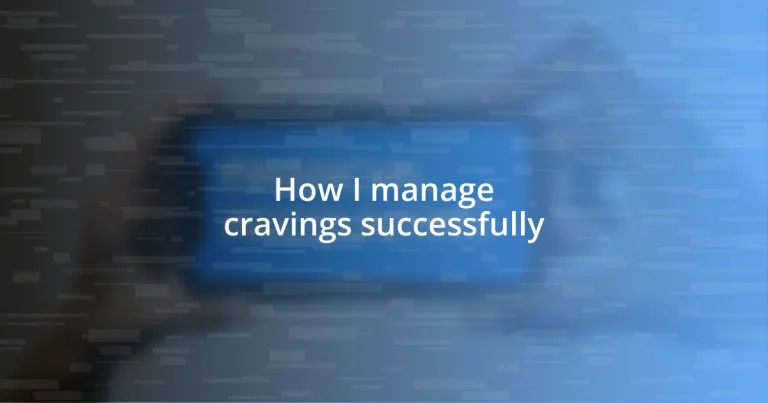Key takeaways:
- Recognizing craving triggers, such as emotions, environment, and time of day, helps in understanding and managing food choices.
- Developing mindful eating practices, including slow eating and emotional awareness, fosters a healthier relationship with food and reduces mindless snacking.
- Creating a supportive environment, tracking progress, and adjusting strategies enhance motivation and improve overall cravings management.

Understanding cravings triggers
Craving triggers can often sneak up on us, and I can’t tell you how many times I’ve felt that sudden urge for something sweet when I’m stressed after a long day. It’s fascinating how our emotions can dictate what we crave. Have you ever noticed how a tough conversation or a hectic day can leave you suddenly reaching for that chocolate bar or bag of chips?
One significant trigger I’ve discovered is the environment around me. For instance, walking past my favorite bakery can spark intense cravings, even if I wasn’t hungry before. It makes me wonder, how often do we let our surroundings control our choices?
Additionally, I’ve found that certain times of the day play a huge role in triggering cravings. For me, the late afternoon slump often leads to a desire for something quick and comforting. It’s almost as if my body is looking for a reward after hours of work. Understanding these patterns not only helps manage cravings but also empowers me to make better choices.

Identifying personal craving patterns
Recognizing my personal craving patterns required some honest self-reflection. I’ve learned that my cravings often align with specific emotions or situations. For example, I’ve noticed that when I’m feeling bored, I tend to reach for snacks mindlessly; it serves as a way to fill that void. Understanding these emotional connections has made me more resilient against these urges.
Here are some patterns I’ve identified in my cravings:
– Emotional triggers: Stress, boredom, or sadness often lead me to seek comfort food.
– Situational triggers: Watching TV at night seems to ignite cravings for chips or popcorn.
– Time-related triggers: Late afternoons or weekends usually bring about a desire for sweets as a perceived reward.
– Social triggers: Eating out with friends can make me indulge in treats I wouldn’t typically choose at home.
By pinpointing these patterns, I feel more equipped to handle those cravings instead of letting them take over. It’s about turning those realizations into proactive strategies for better choices.

Developing mindful eating practices
Developing mindful eating practices has been a transformative journey for me. I remember a time when I would sit with a bag of chips, completely zoned out while watching TV. Now, I intentionally take a moment to savor my food. Whether it’s a piece of fruit or a homemade meal, I try to be present in the moment. By focusing on the flavors and textures, I find that my cravings diminish, as I genuinely enjoy what I’m eating. Have you ever tried slowing down and really tasting your food? It’s amazing how that simple act can change your experience.
Creating a mindful eating routine has also helped me combat emotional eating. When stress hits, I used to turn to snacks as a quick fix, often leading to regret later on. Now, I pause when I feel that urge. I ask myself, “Am I really hungry, or is this boredom talking?” This mindfulness shift gives me the clarity to choose whether to satisfy a craving or to distract myself with a walk or a hobby. It’s like having a conversation with myself that promotes healthier choices.
In addition, I’ve discovered the power of portion control through mindful eating. There was a time when I would serve myself a hefty plate, only to feel sluggish afterward. Now, I practice serving smaller portions and putting away the rest before I start eating. This reduces the temptation to overindulge. As I eat mindfully, I notice that I appreciate the food more, and paradoxically, I feel more satisfied with less. Isn’t it interesting how our perceptions can shift with simple changes in our habits?
| Mindful Eating Practices | Description |
|---|---|
| Slow Eating | Taking time to enjoy each bite, enhancing flavors, and reducing cravings. |
| Emotional Awareness | Recognizing feelings behind cravings and choosing alternative actions. |
| Portion Control | Serving smaller amounts to prevent overeating and promoting satisfaction. |

Creating a healthy snack plan
Creating a healthy snack plan has been a game changer for me. I recall when I used to grab whatever was within arm’s reach, often leading to poor choices. Now, I spend a little time each Sunday planning my snacks for the week. This way, I can prepare a mix of fruits, nuts, and whole grain crackers, keeping everything ready and easily accessible. Have you ever noticed how having a plan in place can keep those impulsive choices at bay?
I also believe in the beauty of variety. When I select my snacks, I ensure that they not only satisfy my cravings but also provide nutritional benefits. For instance, I love pairing apple slices with almond butter for a sweet yet healthy treat. This combination not only curbs my sugar cravings but offers filling fiber and protein. It’s such a relief to realize that I can enjoy flavorful options without feeling guilty. How often do we overlook the joy of nourishing our bodies with tasty snacks?
Moreover, I’ve learned the importance of portion control in my snack planning. Instead of grabbing the entire bag of trail mix, I now portion out single servings in small containers. This small act has made a tremendous difference in my mindset. It’s like setting boundaries for myself; I can indulge without going overboard. Have you ever tried setting limits for your snacking? You might be surprised how a little self-imposed discipline can lead to a sense of control and satisfaction.

Utilizing distraction techniques effectively
Utilizing distraction techniques has become a vital part of managing my cravings. There are moments when all I want is to reach for a sugary treat, but I’ve learned that redirecting my focus can make a world of difference. One effective method I’ve found is diving into a good book or losing myself in a riveting podcast. I remember finishing a gripping novel instead of snacking mindlessly, and I felt a rush of accomplishment afterward—like I had not only avoided a craving but also enriched my mind. Have you ever noticed how a compelling story can absorb you completely?
Sometimes, a quick physical activity helps shake off those lingering desires. I keep a pair of dumbbells next to my desk as a reminder to move rather than munch when cravings strike. A simple ten-minute workout can clear my mind and shift my mood. For instance, just the other day, I grabbed the weights instead of the cookie jar. That small decision transformed my urge into energy. Isn’t it fascinating how movement can replace temptation with motivation?
Engaging with a hobby can also be an incredible distraction. I’ve taken up painting, which allows me to express myself creatively while keeping my hands busy. On days when cravings are particularly strong, I find that mixing colors and losing myself in the canvas brings such joy that the thought of snacking fades away. Does that resonate with you? How often do we have untapped passions waiting to fill the space where cravings linger?

Building a supportive environment
Creating a supportive environment has been crucial for me in managing cravings effectively. I’ve surrounded myself with people who share similar goals, often turning to friends for encouragement. Just last month, I hosted a healthy potluck. Everyone brought a nutritious dish, and it was not only delicious but also inspiring to see how we can enjoy good food together without the typical unhealthy options. Have you thought about who in your life could join you on this journey?
I also make it a point to declutter my living space, ensuring that temptation isn’t just a glance away. Last year, I went through my pantry and threw out all the processed snacks that had been haunting me. That simple act felt liberating. I realized that when my environment is free of those tempting options, it’s much easier to stay on track. Does a clean space resonate with your feelings about food?
Moreover, I’ve involved my family in my journey towards healthier choices. Sharing my goals and discussing cravings has created an open dialogue. My kids now understand why we opt for fruit over chips, and sometimes they even help me in the kitchen preparing healthy snacks. Seeing them enjoy the healthier options brings me joy, and it reinforces my commitment. Have you considered how involving loved ones can transform not just your habits, but theirs as well?

Tracking progress and adjusting strategies
Tracking my progress has been an eye-opener in my journey to manage cravings. I started keeping a simple journal, jotting down each time I resisted a temptation. Over time, I could actually see patterns emerge: certain days would be tougher than others. Does tracking your own patterns feel like putting the pieces of a puzzle together?
Adjusting my strategies based on what I observe has been a game changer. When I noticed that cravings peaked during certain stressors, I began incorporating stress-relief techniques, like mindfulness meditation. One day, after a hectic week, I skipped my usual treat and chose to meditate instead; the sense of calm afterward was far more rewarding than that fleeting sugar rush. Have you tried reassessing your triggers to find what works best for you?
Furthermore, I embrace the idea of being flexible with my approach. I once tried to go cold turkey on my favorite snacks and found it made me crave them even more. Instead, I now allow myself small, controlled portions as part of my meal plan. Balancing indulgence with mindful eating has kept me on track while satisfying my cravings—it’s a win-win! How do you find harmony between indulgence and restraint?














